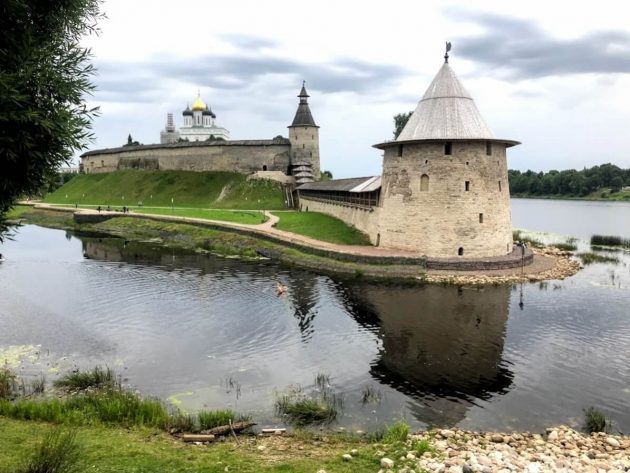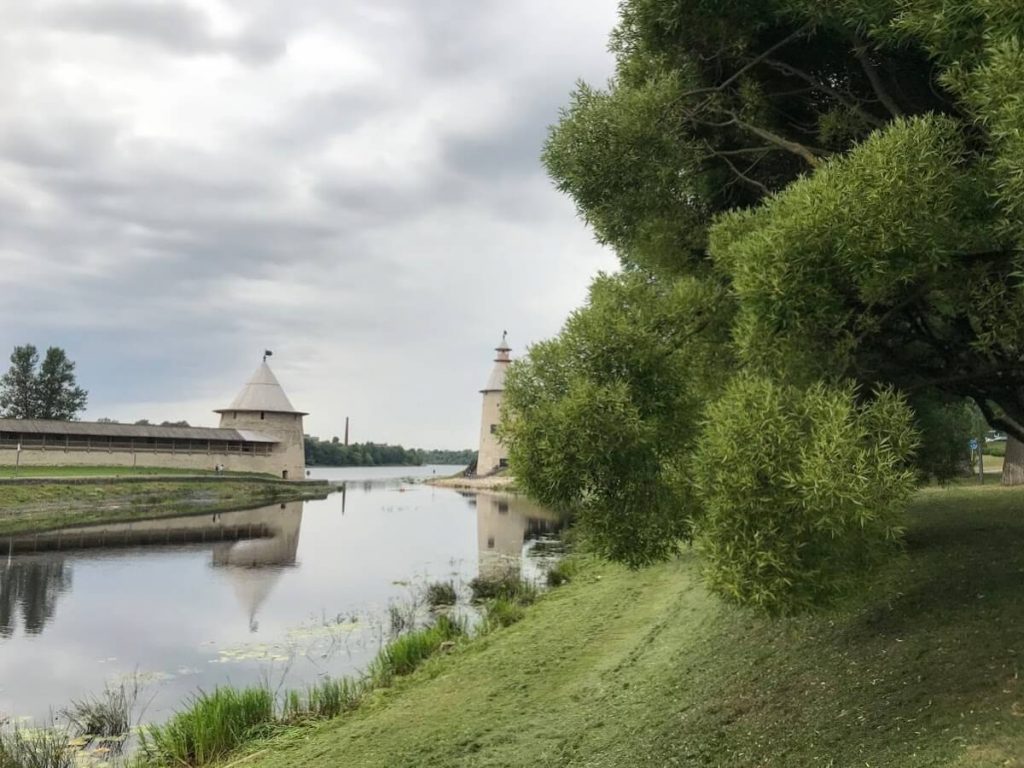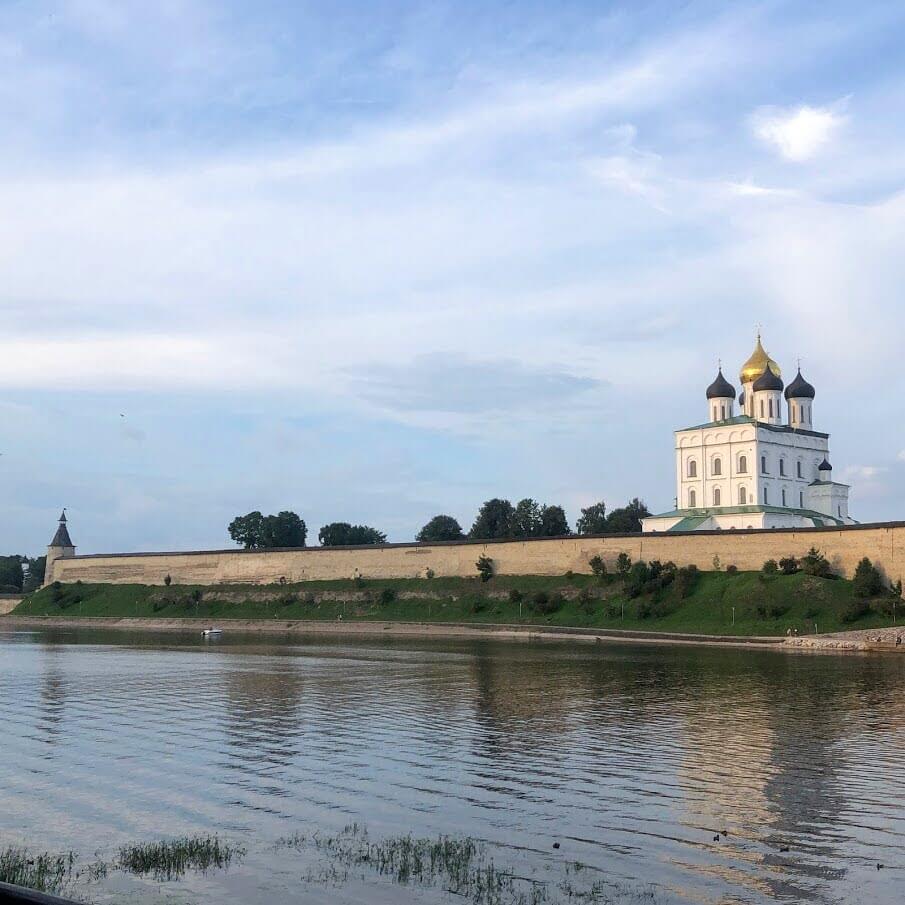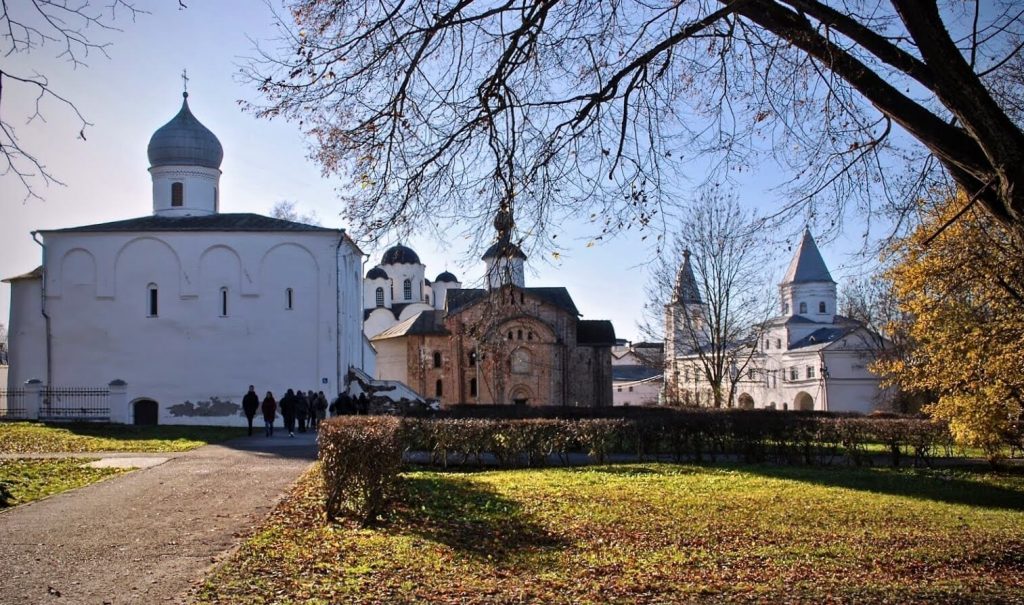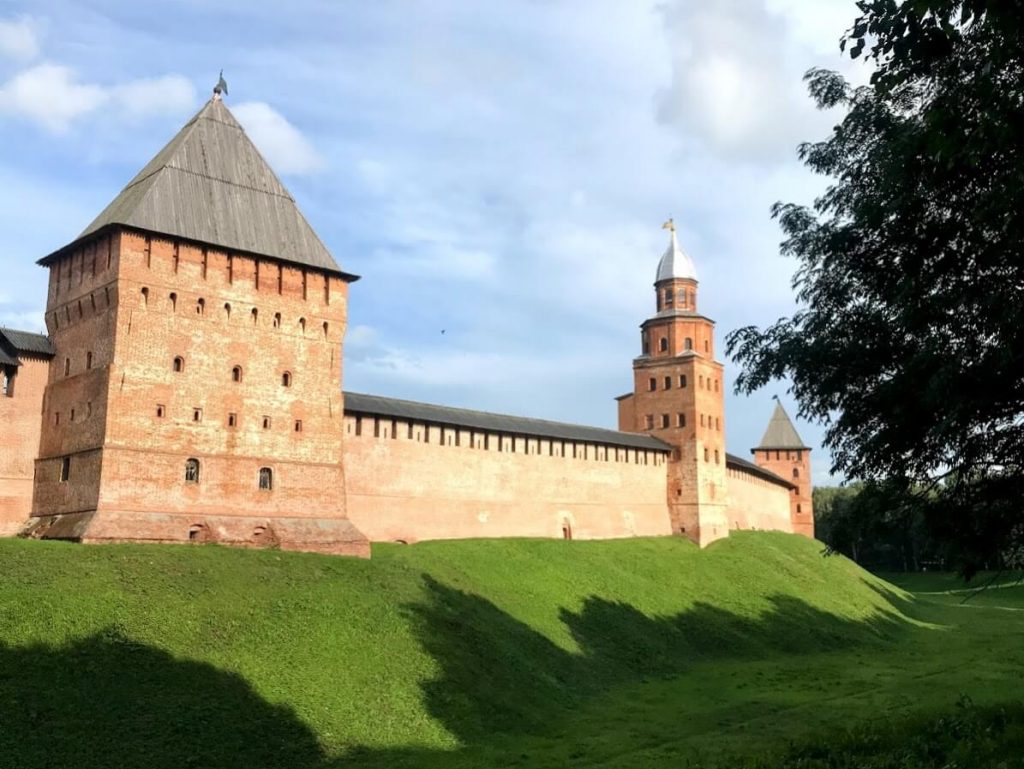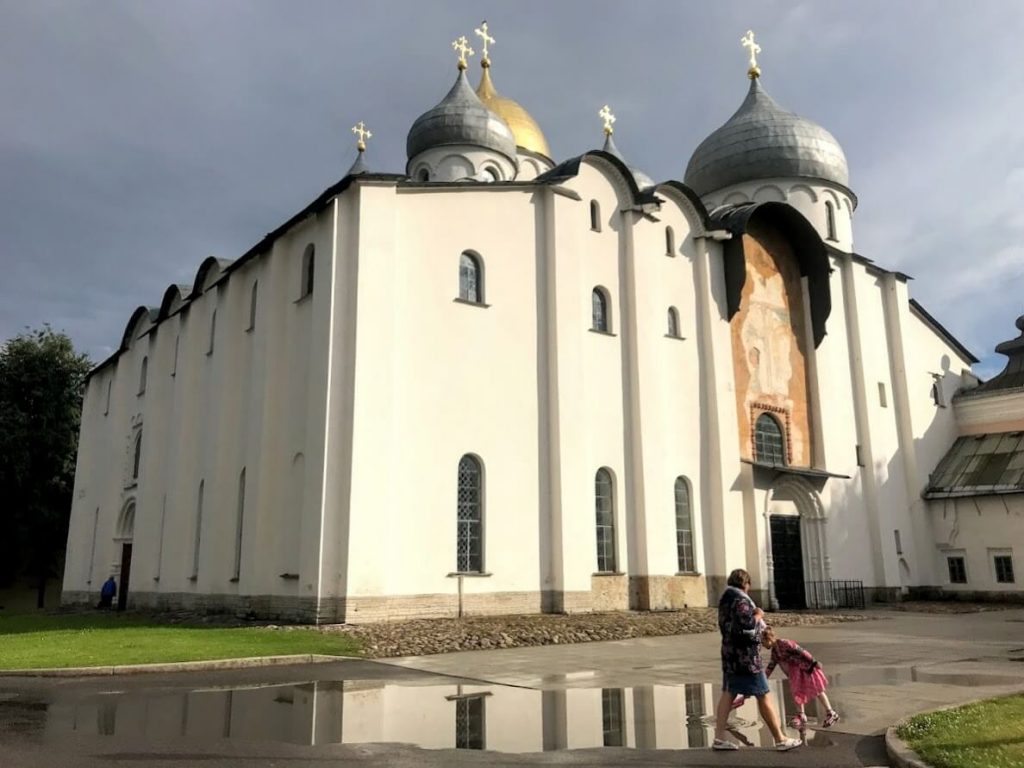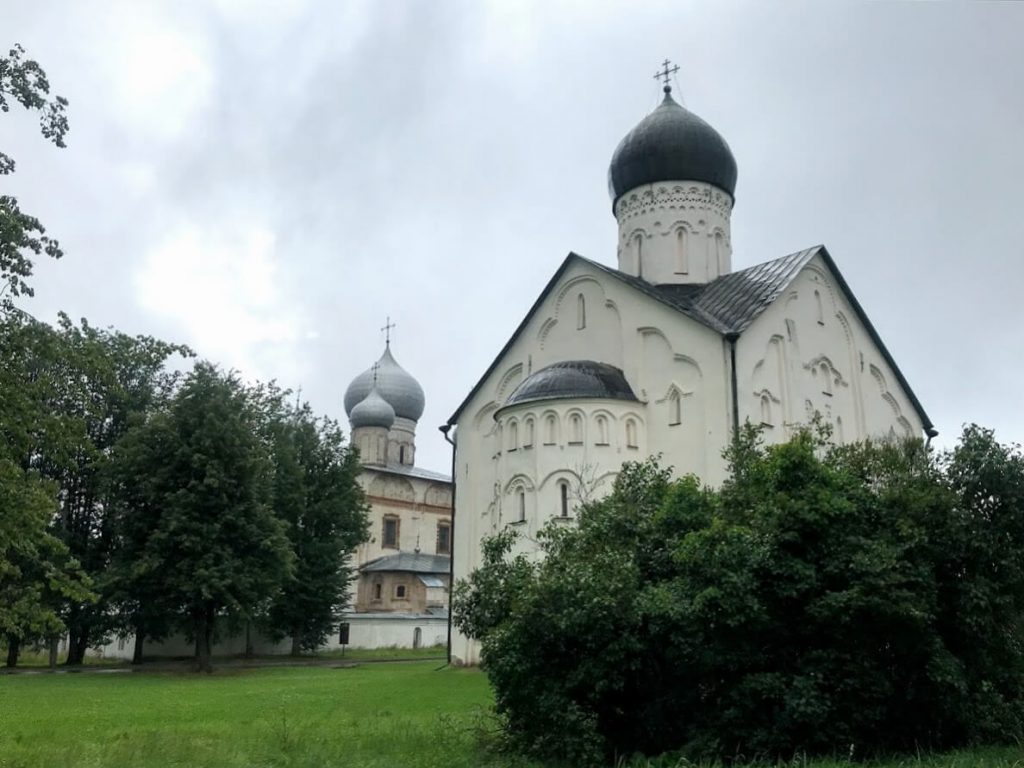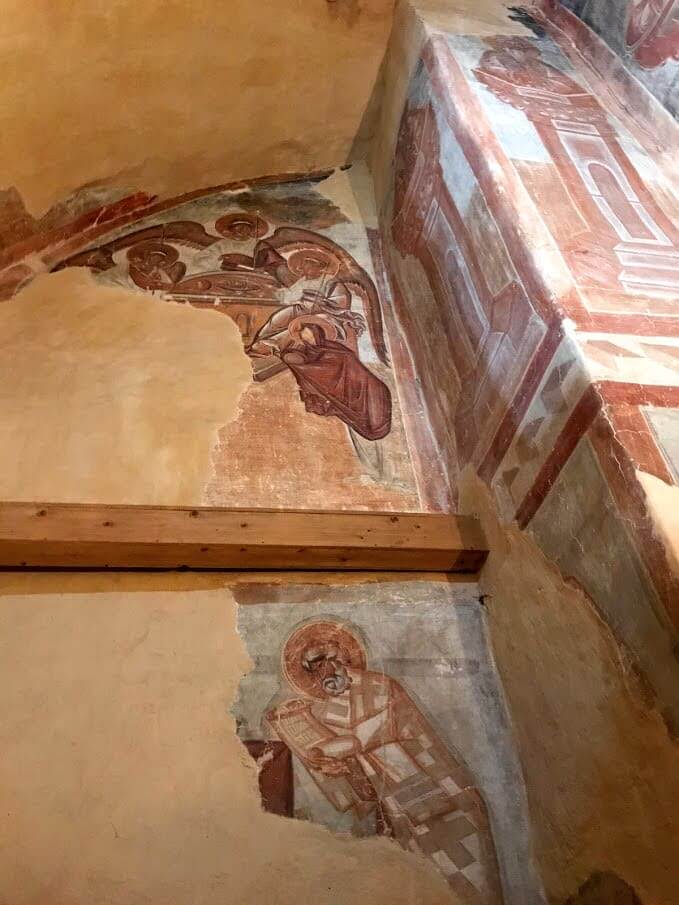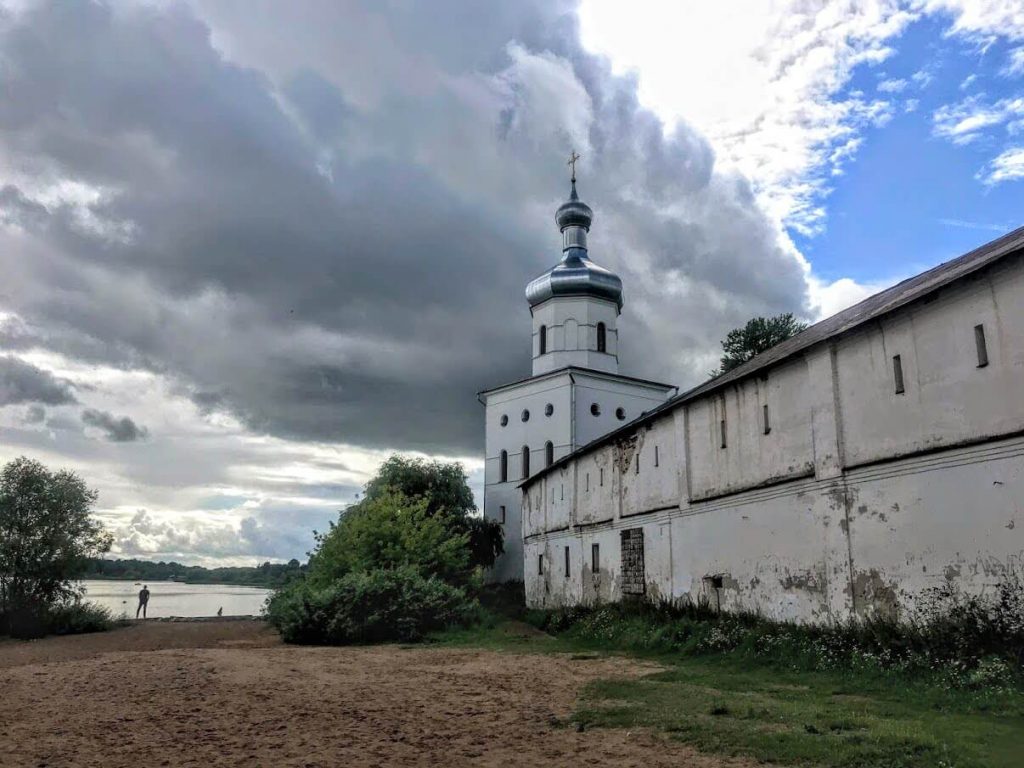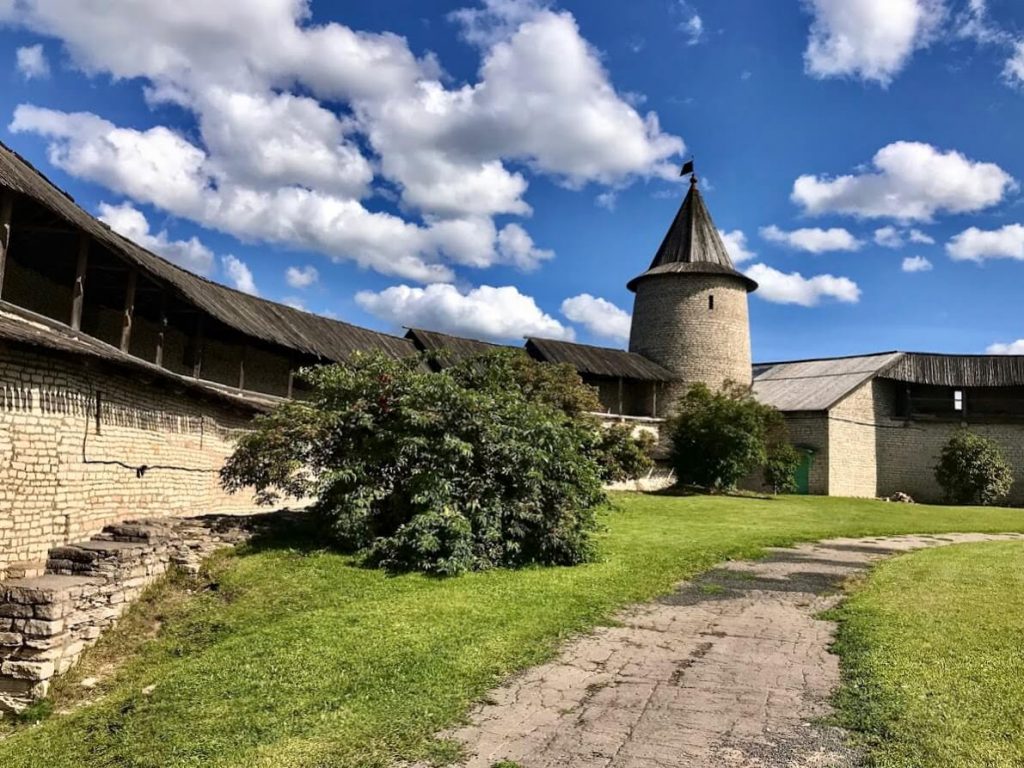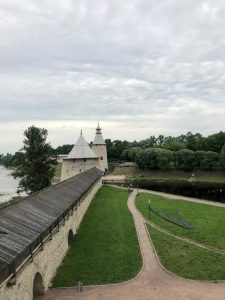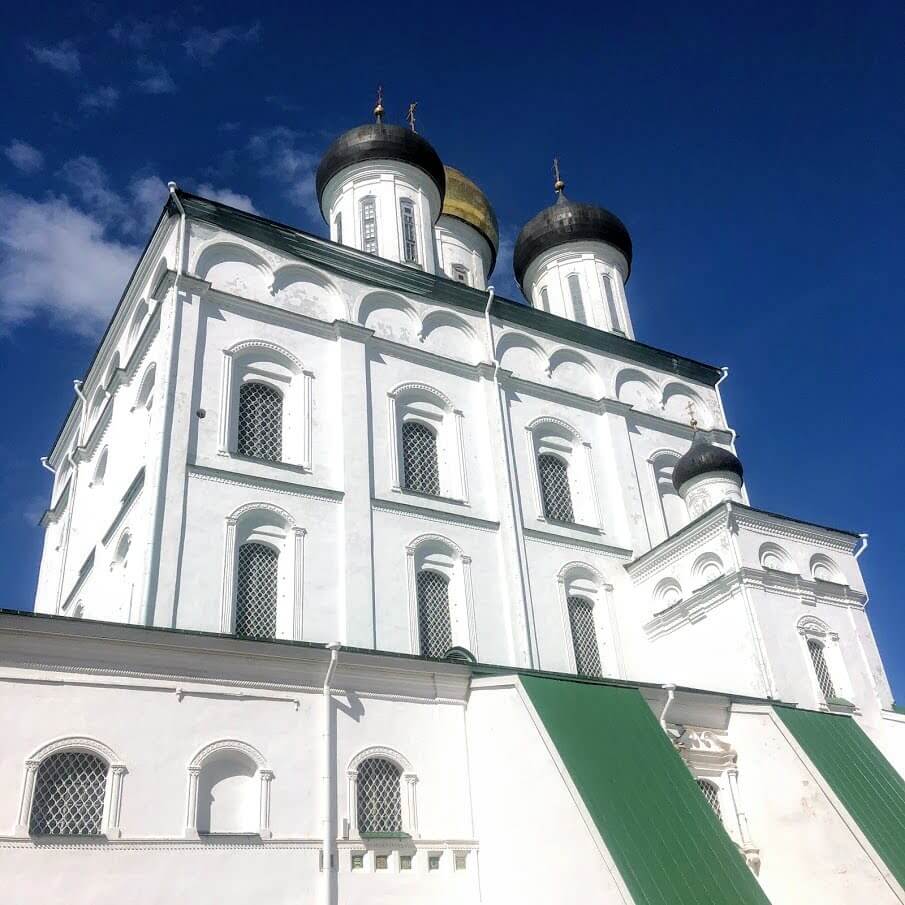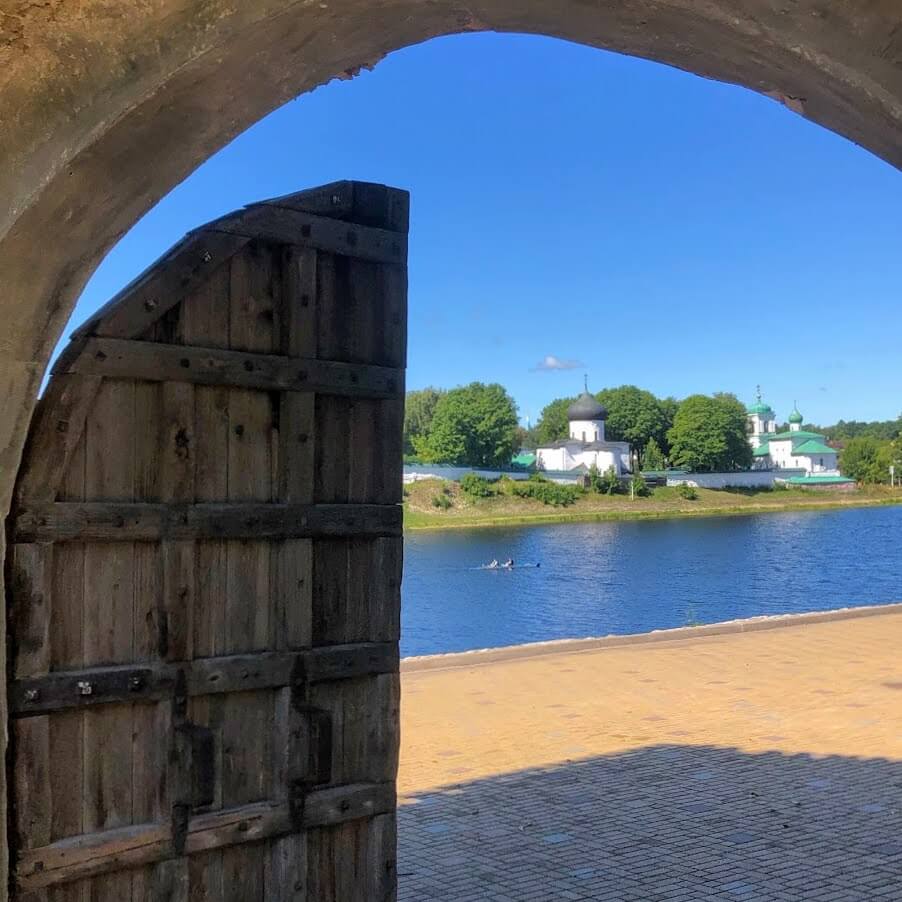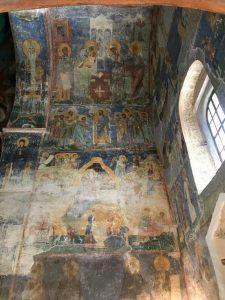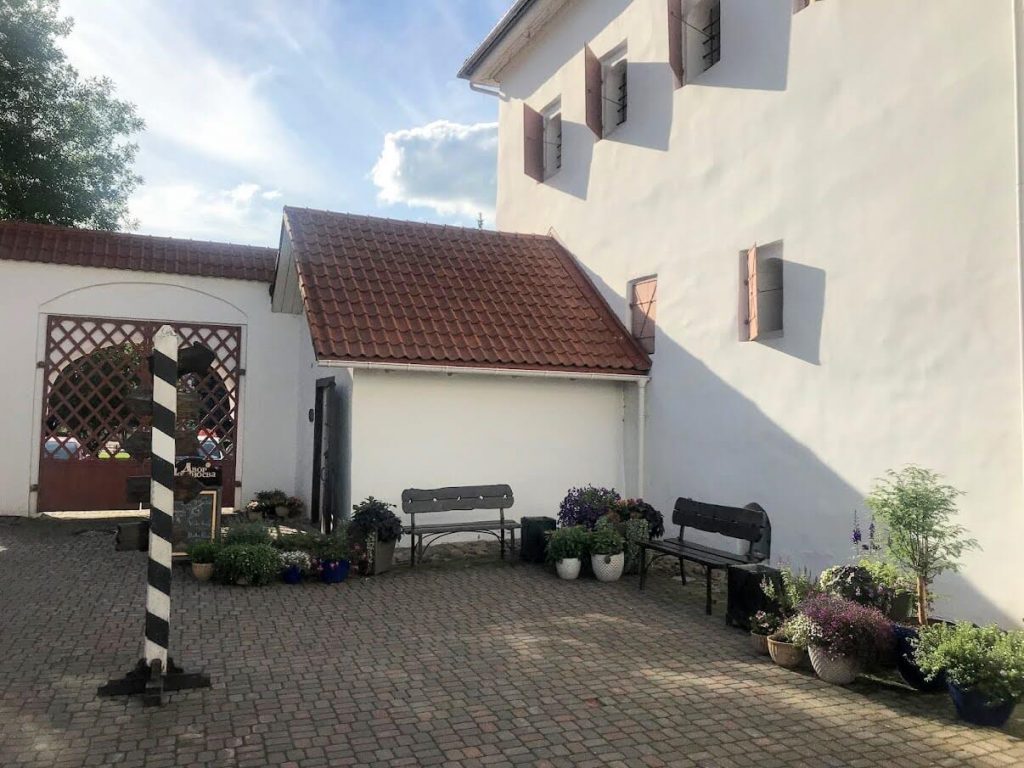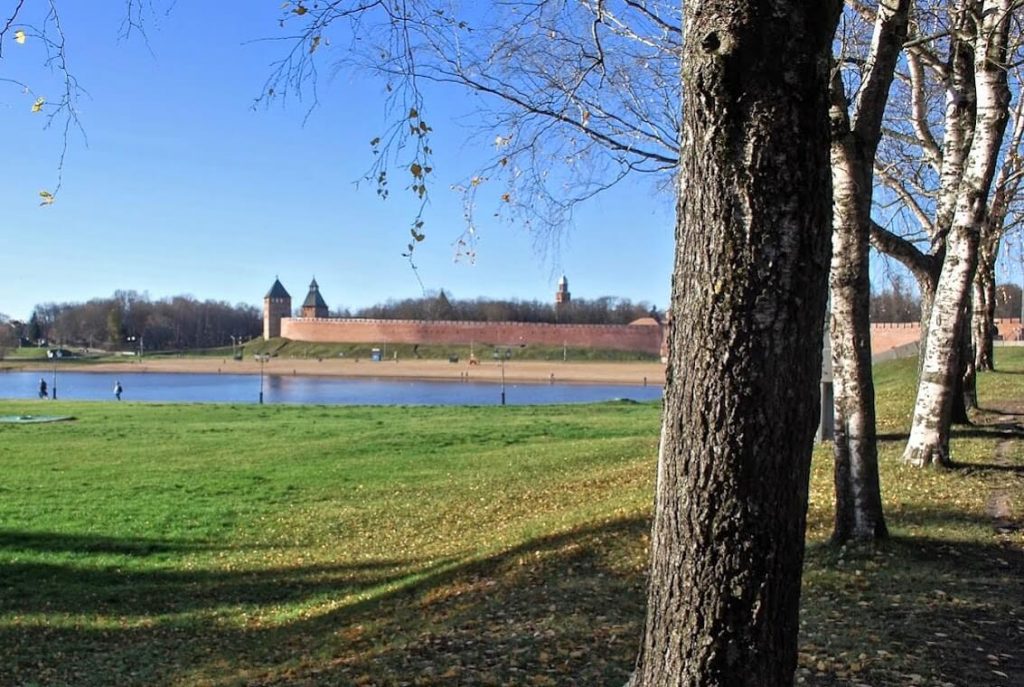What are the most exciting places to visit in Russia? For most tourists, the choice is limited to Saint Petersburg, Moscow and royal residences nearby. But what are those unexplored, reserved Russian towns described in many classic books and movies? Well, look no further. Here is a story about two beautiful old cities and a guide to visiting Veliky Novgorod and Pskov.
Visiting Veliky Novgorod and Pskov
This is a guest blog post about visiting Veliky Novgorod and Pskov, written by Alexandra and Karina, local Russian art and history experts. You can read more of their stories and check out some beautiful art tours they are organising on a link here.
Suppose you are really interested in Russian history and culture, and there are a few extra days in your trip itinerary. In that case, this Veliky Novgorod and Pskov guide is for you! In it, you’ll learn about ancient Russia and how to visit the places from where the Russian State began many centuries ago.
Visiting Veliky Novgorod and Pskov is not hard from Saint Petersburg. They could be easily visited on a one-day or two-day trip from there. According to ancient annals, in the 9th century, the Russian statehood and nationality were formed under the rule of the Rurik Dynasty.
In those two cities, both protected by UNESCO, the grandest amount of Russian medieval architecture and art is concentrated. Every stone in the walls of their Kremlins and old pavements literally breathes with history, and their deep cultural layer still keeps many mysteries.
⤷ Read more: Saint Petersburg Travel Guide
How to get to Veliky Novgorod and Pskov from Saint Petersburg
⤷ Veliky Novgorod is located some 180 km from Saint Petersburg. It can be reached by train, bus or car via the new highway. Trains to Veliky Novgorod leave from Saint Petersburg Railway Station just off the Nevsky Avenue. Rail journey will take you three hours in a comfortable train, and it is more recommendable if you are getting there on your own.
⤷ Pskov is further away from Saint Petersburg in the direction to the border with Estonia and Latvia. The most convenient way to get to Pskov is by Lastochka express train that leaves Baltiysky Railway station (Metro Station Baltiyskaya). The journey is 3,5 hours long.
There is also a daily Lastochka train that connects Veliky Novgorod and Pskov – so you can actually combine the visit to both cities and return to Saint Petersburg! The journey time on this express train between Novgorod and Pskov is around four hours.
History Overview: Where does the Russian land come from?
According to the legends and the Primary Chronicle from the 9th century, various pagan Slavic tribes, warring between each other, decided to seek the prince across the sea to establish peace in their lands.
Our land is great and abundant, but there is no order in it. Come to reign and rule over us.
Three Varangians responded to this call – they were attracted by the wealth of vast overseas territories. Their names were Rurik, Sineus and Truvor. According to one version, they were called the Rus, hence the name Russia.
The historians still argue about who they actually were and where did precisely they come from. Still, there is no doubt that the state was actually born in the northwest of present-day Russia.
Rurik Dynasty is a princely, and later royal family of descendants of Rurik – the first prince of ancient Russia, mentioned in chronicles. They ruled Russia for six centuries. As time went by, the dynasty was divided into numerous branches – principalities. The descendants of Ruriks also ruled in Croatia in union with Hungary, Grand Duchy of Lithuania, Bulgaria and Georgia.
⤷ Read more: Visiting Hermitage Museum in Saint Petersburg
History of Veliky Novgorod and Pskov
In the vicinity of old settlements on Vokhov and Pskova rivers’ shores, soon significant and prosperous cities grew up. Novgorod (first mentioned in 859) and Pskov (first mentioned in 903) later became the largest cities of medieval Europe and part of Hanseatic League.
Both cities played a crucial role in the formation of the Russian national character. As well as cultural, economic, religious life, and the social structure of the future Russian Empire.
For many centuries, these lands were known as Republics. Until the mid-15th century, Novgorod and Pskov were economically independent city-states. The power in them belonged to ‘Veche’ – the union of boyars (nobility in pre-Imperial Russia), tradesmen and free citizens. They ruled the cities, as well as chose the prince governor and archbishop. The prince could not take any important political decision without their approval. Thus, his power was limited to the army and court administration.
⤷ Read more: The history behind Fabergé Eggs
During the Tatar-Mongol invasion’s difficult period, the rich lands of Novgorod and Pskov were not ruined. However, they had to pay tribute to the Horde. Therefore, they did not cease developing politically and economically during the 13th and 14th centuries.
The structure of Novgorod and Pskov Republics resembled the social and political system of the Venetian Republic in many ways. The Republic of Novgorod was particularly large – it stretched to the White Sea in the north and beyond the east’s Ural Mountains.
Between the mid 15th and early 16th century, the Republics lost their independence when they were conquered by the Moscow principality and united with the rest of Russian principalities.
Hopefully, this short overview will help you understand what immense cultural wealth is hidden in these lands. They are the key source of information about everyday life in ancient Russia. They preserved both the largest number of common household objects and examples of Russian medieval art. There are still many ongoing archaeological excavations in them.
⤷ Read more: Visiting Peterhof Palace from Saint Petersburg
What to see in Veliky Novgorod in a day
Kremlin – Detinets
Just like in the case with other ancient Russian cities, the political, religious and cultural centre of Veliky Novgorod was Kremlin. Novgorodians actually call their inner citadel Detinets. During its heyday between 12th and 15th century, Detinets was the centre of the Novgorod Republic. The archbishop’s courtyard was also located there.
In the beginning, the Kremlin of Novgorod, just like the entire city, was made of wood. Still, in the 11th century St. Sophia, the main city cathedral, was constructed in stone. Shortly after that, the Kremlin walls were rebuilt in stone with mighty towers (as much as 6,5 metres thick in some places). Initially, there were twelve towers, of which nine have survived to our day. Each one had access to the fortress wall’s battle course, while the ammunition was stored in the lower tiers.
The Detinets of Novgorod is the first Russian fortress built from red bricks. Following it, other similar forts with typical spikes in the form of a swallow’s tail were constructed across Russia, such as the Moscow Kremlin.
St. Sophia Cathedral
The city’s religious life has always been linked to the Cathedral of St. Sophia – the oldest church in Russia. The majestic cathedral was constructed on the site of the burned down wooden church in only five years (between 1046-1050). Consecrated in Saint Sophia’s name, it was modelled after the Hagia Sophia of Constantinople, the main Orthodox shrine.
St. Sophia of Novgorod has five main domes, and it seems to stretch out to Heaven. It became an example for all Novgorod churches. It was painted white in the mid-12th century, but some of its surviving frescos date back to the 11th and 12th century. The cathedral’s main icon is the miraculous Our Lady of Sign, created in the 12th century. Unfortunately, most of the old frescos were destroyed during the Second World War.
As with many cathedrals around the world, this one also has an interesting legend link to it. Every local in Novgorod knows the legend about the dove on top of the central dome of St. Sophia!
In the Orthodox tradition, the dove is the symbol of the Holy Spirit. As the legend says, in 1570, when tsar Ivan the Terrible ordered to slaughter thousands of the Novgorodians, a dove set upon the cross of St. Sophia. When it saw the massacre, it turned into stone, and the monk of the cathedral saw the Holy Virgin. The latter told him that this dove was sent to the city as a consolation and until it sits there, Novgorod will be protected by the Lord.
The cross with the dove stayed there until 1942 when it fell down after the shelling. It was taken out of the city together with other cultural values by the Spanish Blue Division, who fought on the side of the Nazis. Only in 2002 it was found in Madrid and returned to Veliky Novgorod. The cross that you see on the dome now is the post-war copy, the original cross is inside the cathedral. But locals still believe in the old legend and know that until the dove is in St. Sophia, the city is safe!
⤷ Read more: Places linked to Leo Tolstoy in Moscow
Church of the Transfiguration
Many old Veliky Novgorod churches are situated just across the pedestrian bridge from the Detinets, in the city neighbourhood called Yaroslav’s Court.
However, one church that should be mentioned separately, is a bit further away from Yaroslav’s Court – a small one-dome Church of the Transfiguration. It was built in the 14th century, and is situated on Ilyina Street. It mesmerises with its original decorations and the harmony of proportions, typical of all Novgorod churches.
It gained its worldwide fame thanks to the frescoes made by Theophanes the Greek, an outstanding icon painter. This Byzantine artist came to Russia as an already established master. His frescos in the Novgorod church became his first work in Russia and the only surviving example of his monumental painting in the world.
As most other frescos of that epoch, they are only partially preserved, but even these fragments allow us to fully appreciate an outstanding talent of their author, his expressive, laconic, and at the same time, free manner of painting.
⤷ TIP: At times of heavy rains and snowfalls, the church may be closed.
If you spend two days in Veliky Novgorod, you’ll have more time to explore other ancient churches. In that case, be sure to visit the legendary St. George (Yuriev) Monastery and the Museum of Wooden Architecture Vitoslavitsy, take a boat ride or visit the History Museum in Novgorod Kremlin with old icons, birch bark manuscripts and other medieval objects.
⤷ Read more: Explore Saint Petersburg in the footsteps of Fyodor Dostoevsky
What to see in Pskov in a day
Pskov is quite remarkable because it was the city of the holy Princess Olga. She was the first woman on the Russian throne and the first princess mentioned by the chroniclers. No woman before her received such an honour.
Russia was later on ruled by many women. But, probably, the reign of courageous Olga in Pskov became the prologue to the 18th century – the century of women on the Russian throne, where particularly empresses Elizabeth and Catherine II stand out.
Olga, who came to power after the death of her husband Prince Igor, became the first Christian ruler of Rus – thirty years before Russian principalities adopted Christianity officially in 988 in Kyiv. Olga was baptised in Constantinople, while her family and other people in Russia kept practising paganism.
The social system of Pskov was distinguished by the greater role of merchants. This city of traders had been the mixture of various cultures, thanks to its position on the border with other countries.
Therefore, Pskov has always protected Russia’s western borders – this role strengthened the position of its army and urban lower classes. Simultaneously, life in the city was distinguished by even greater democracy than in Veliky Novgorod.
Kremlin – Krom
Just as you see thick unapproachable walls of the Pskov Kremlin, Krom, standing at the intersection of rivers Pskova and Velikaya, you will feel that the spirit of Pskov is somehow harsher than that of Novgorod.
⤷ TIP: Veliky or Velikaya is the word for ‘Great’ in Russian. Thus, the city of Novgorod is called Novgorod the Great. And the name of the river that flows through Pskov can be translated as the Great River.
These were not the only fortification walls of Pskov – the medieval city was surrounded by five rings of defensive walls! When strolling around Pskov, you will often find their fragments here and there. Like ancient guards, they remind us of the heroic past of Pskov and the numerous attacks it was exposed to.
With such a defensive system, the city was inaccessible. By the 16th century, it was surrounded by 37 towers, while the total length of the fortress walls reached ten kilometres. Even when the enemy managed to get through the first fortification ring, it could not reach Krom.
Trinity Cathedral
In the centre of Krom, you will see a gigantic Trinity Cathedral. It was the main construction of the old city, that still dominates it with its 78 meters height and the stern look. Today’s cathedral is the forth, it stands on the place where in the 10th century the first wooden church was built by Princess Olga’s request.
Trinity Cathedral possesses unique seven-tier wooden iconostasis built in the 17th century. Centuries ago, at the square in front of the cathedral, the rulers of Pskov were elected.
⤷ Read more: Art Nouveau in Saint Petersburg
Mirozhsky Monastery
This 12th monastery is situated on the opposite side of Velikaya River, just across the Krom. It is one of the oldest monasteries in Russia. However, it is unique not only because of that – it preserved 80% of magnificent pre-Mongol frescos in its main church! The names of fresco artists are unknown, but we know they came from Greece.
Thanks to the Mirozhsky frescoes, the local school of icon painting began to develop in Pskov. The first Pskov icons were created there. Today, they are almost intact, because, like many other medieval paintings, they were whitewashed during the 17th century. And they were just rediscovered at the end of the 19th century.
⤷ TIP: Pre-Mongol monuments are those works of art created in the Russian principalities before the Tatar-Mongol invasion of 1237- 1480. These works are closely linked to the Byzantine tradition. The largest number of them can now be found in Veliky Novgorod and its surroundings, Pskov and Staraya Ladoga.
Today there are more than 50 old churches in Pskov, but most of them date back to 14th and 15th centuries – Pskov Republic’s heyday.
Palaty – Old Civil Buildings of Pskov
Pskov is home to several old stone houses of locals. They are called palaty in Russian. That word is used for all stone civil buildings in Russian cities that date back to the epoch before Peter the Great’s reign. Most of them were constructed between the 15th and 17th century.
The palaty in Pskov are huge in comparison to those preserved in Moscow and other old Russian cities. The most distinguished ones are the Palaty of Menshikov and Pogankin. They have massive fortified walls and small windows – loopholes, which again demonstrates the fierce spirit of Pskov and its inhabitants.
Today, Pogankiny Palaty is a museum with wonderful Pskov icons created between 14th and 17th century, table silver and medieval archaeological findings. Menshikovy Palaty house a souvenir shop with trademark pottery of local masters.
Pskov, just like Veliky Novgorod, is rich in treasures that archaeologists still keep finding in the foundations of wealthy medieval houses. Among the latest discoveries are the treasures found in 2004 during the construction of the Courtyard of Podznoev Hotel. There, the burial place of a noblewoman who lived about a thousand years ago was situated.
She was coined the Varyagian Guest, and it seems that she could have been in the inner circle of legendary Princess Olga. If you stay in that hotel, you can see the copies of these findings. The originals are now in the collection of Pogankiny Palaty.
The hotel is also united with Podznoev Palaty – reconstructed old palaty of local merchant Podznoev, that’s nowadays home to several restaurants.
In this post, we shared with you just some of the beautiful sights you can see in Veliky Novgorod and Pskov. We hope, this article will encourage you to visit these two cities, the cradles of the Russian culture, appreciate their stern northern beauty and domes of their numerous ancient churches with your own eyes!
⤷ TIP: If you’d like to visit Veliky Novgorod and Pskov, be sure to contact Alexandra and Karina to get more detailed recommendations for your trip or to request a tour!

